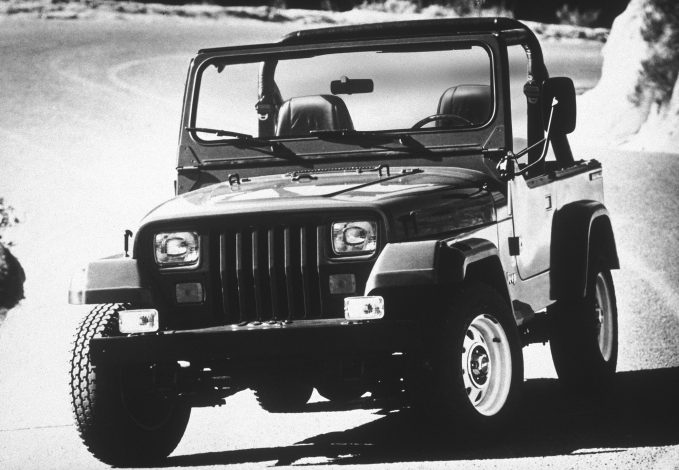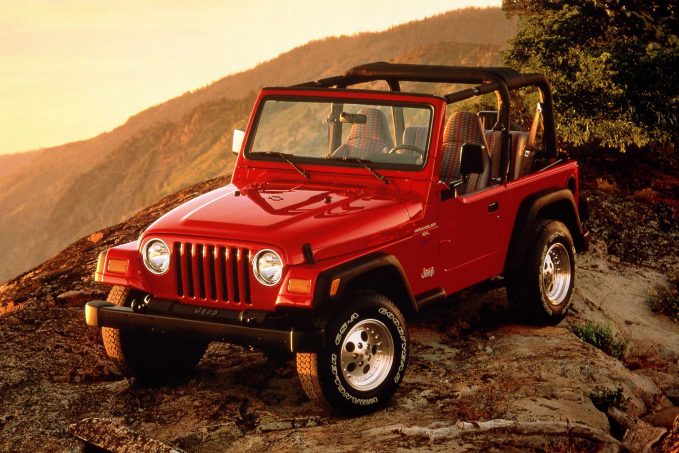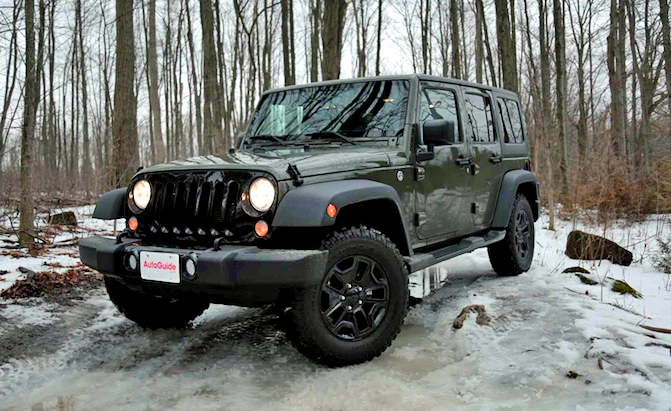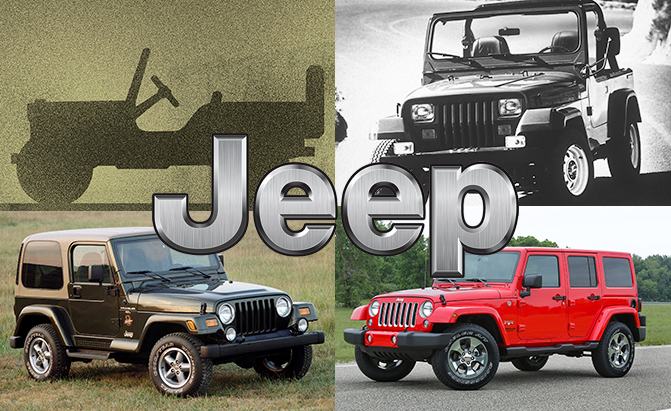It would be easy to mistake the modern-day Jeep Wrangler for the direct descendant of original Willys MB 4×4 that served the Allies with astonishing versatility in the Second World War. In truth, however, the Wrangler’s O.G. Jeep looks are the only thing tying it to its spiritual predecessor.
Introduced in 1986 as a replacement for the great-great grandson of the Willys MB — called the “Jeep CJ” — the Wrangler or “YJ” took a lot of heat from hardcore Jeep fans who felt betrayed by any movement towards modernity.
This certainly seems like a strange attitude today, given that the current version of the Jeep Wrangler stands as the most anachronistic SUVs on the market. Let’s take a look at how Jeep’s ultra-popular off-roader made it from upstart to venerated elder statesman.
1987-1995: Winning Hearts and Minds

When the Jeep Wrangler (or YJ if you refer to chassis codes) appeared for the 1987 model year, the basic American Motors (AMC) formula that had underpinned the old CJ remained in place: solid axles front and rear, a body-on-frame design, removable doors and roof, and a folding windshield were all present and accounted for. There were a number of key changes, however, that separated the Wrangler from the CJ — and we’re not just talking about the move from round headlights to square ones that drew the ire of traditionalists.
The most important differences to be found on the new Wrangler involved its drivetrain, chassis, and interior. The old CJ was a very capable vehicle, but it was heavy and thirsty – and given rising fuel costs, parent company AMC had a hard time justifying continued production of their war-ready dinosaur when they had seen how successful a better-engineered solution like the four-door XJ Cherokee (which had gone on sale in 1983) could be on the market.
Lighter and wider, the Wrangler offered updated leaf springs rather than the coils that could be found in the Cherokee. It also offered trackbars and swaybars, which were not found on the CJ, in order to provide better body control on the road and improve comfort. The Wrangler initially featured a familiar choice between a 117-horsepower, 2.5-liter four-cylinder engine that was also good for 135 lb-ft of torque, or a 4.2-liter V6 that generated 114 horsepower and 210 lb-ft of torque. But by 1991, a fuel-injected 4.0-liter straight-six (boasting 180 horsepower and 220 lb-ft of twist) that was still derived by AMC would tag in for the older carbureted unit. Transmissions included three-speed autos and five-speed manuals, depending on model year and engine choice.
Shortly after introducing the Wrangler, the entire Jeep brand would change hands, being sold from AMC to Chrysler for a heady $1.5-billion in 1987. This would spell the end of Wrangler production in Ontario, Canada, and eventually bring the now-famous Toledo, Ohio, plant online.
Fun fact: Wrangler jeans would actually sue Jeep for the use of the Wrangler name, a legal conflict that would eventually end when the garment brand changed hands and the new owner realized how ridiculous the entire situation was. YJ Wranglers, of course, rode on Goodyear Wrangler tires, after having first obtained the OK from the rubber chieftains to share the same name.
1997-2006: Enter the TJ

For reasons lost in the mists of time, there were no actual 1996 model year Wranglers, only leftover ’95 stock and a number of 1996-build vehicles that were sold as ’95s. Still, that lost year was worth the wait for many Jeep fans because it saw the return of round headlights to the Wrangler fold, erasing a wrong that had collectively offended scores of enthusiasts.
Dubbed the TJ, the new generation of Jeep Wrangler was the first to bear the imprint of Chrysler’s design and engineering departments, and it made a number of improvements to the 4×4’s formula. Jeep claimed 80 percent of the vehicle’s components were new, and you didn’t have to look too far past the CJ-friendly styling to find goodies like coil springs front and rear (which added seven inches of articulation), as well as a taller ride height (the YJ Wrangler had actually been a smidgen lower than the CJ). The vehicle’s frame was also 100 percent stiffer as compared to the YJ.
Mechanically, there were no changes to drivetrain options until 2003 (when a four-speed automatic replaced the ancient three-speed and brought with it a 2.4-liter, four-cylinder engine producing 147 horsepower), but the TJ did gain driver and passenger airbags and was slightly more aerodynamic with the roof in place. 2003 also saw the introduction of the hardcore Rubicon model, named after the famous off-road trail. The Wrangler Rubicon delivered unique rock-crawling capability thanks to its special low-range gearing and four-wheel drive system, featured knobby 31-inch tires, and came with a slight ground clearance boost as well as locking front and rear Dana axles.
As important as the Rubicon was to Jeep’s branding strategy, a far more critical decision was made for the 2004 model year — and one that would eventually boost the fortunes of the Wrangler to a high never before seen by either AMC or Chrysler. By stretching the vehicle’s wheelbase by 10 inches and calling it the ‘Wrangler Unlimited,’ Jeep was able to tap into a fresh pool of customers for the TJ, not to mention the fact that the longer 4×4 was more stable at speed and almost doubled its towing capacity to 3,500 lbs.
2007-present: The Last Hurrah

When the JK generation Jeep Wrangler hit the trail as a 2007 model, it marked the end of decades of history. With the TJ gone, there were no longer any AMC-sourced parts to be found in a current automobile, consigning that once proud automaker to the scrap heap.
Specifically, it was the demise of the 4.0-liter six-cylinder engine in favor of a corporate Chrysler 3.8-liter V6 producing 202 horsepower that fully erased the AMC connection. Matched with either a fresh six-speed manual or a four-speed automatic transmission, this drivetrain was known for its pokey performance — especially since the wider and longer JK packed a much stiffer frame and body which added an extra 200 lbs to what the TJ had weighed. When a 285 horsepower 3.6-liter V6 appeared for the 2012 model year (bringing with it a five-speed automatic option), there was much rejoicing in the Jeep community.
Aside from styling improvements and a massive leap forward in terms of infotainment, the JK Wrangler also opened up the sales floodgates we hinted at earlier by way of the revised four-door Wrangler Unlimited. Specifically, buyers were now able to justify their desire to own a Wrangler by pointing to its day-to-day practicality and boost in cargo space, adding a potent weapon to Jeep’s arsenal and making the Wrangler a legitimately family-friendly option in Unlimited trim.
ALSO SEE: Details on the 2018 Jeep Wrangler Leak Ahead of its Debut
Despite being the best-driving Wrangler to date, the JK is still very much a technological dinosaur in terms of its suspension and chassis design. It also likely represents the last of the breed, given that whatever new Wrangler debuts for the 2018 model year will most likely feature a more modern, and efficient platform in order to meet every-shifting safety and efficiency standards. If you’ve ever wanted to experience what it’s like to own a traditional Jeep, snag a Wrangler while you still can.



Leave a Reply